Exercises (2269)
Push-up on knee ► knee push up / kneeling push up (close grip)
Power
Individual work
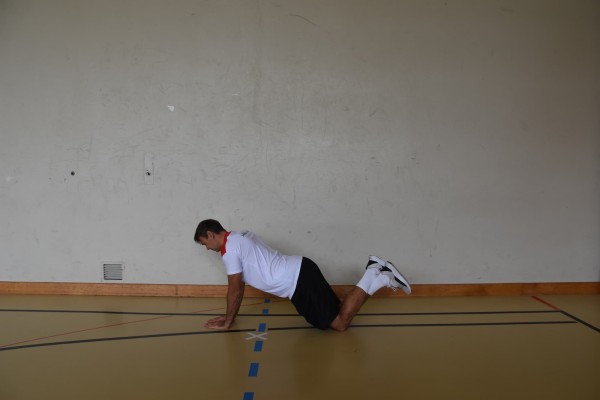
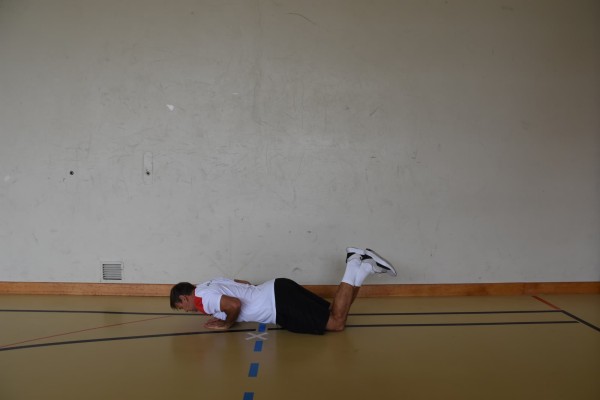
In the knee push-up position (knees on the floor, feet held high with toes raised, body forming a straight line from head to knees, hands together under the chest), bend and stretch the arms (lower and raise the upper body).
Attention:
No hollow back and elbows bent at an angle of approx. 45° from the upper body ("A" shape with the arms). Keep your shoulders fixed and pull them down towards your hips.
Lighten:
Lower your upper body less (hardly bend your arms); support your arms on a raised surface.
Harden:
Additional weight (on the back); unstable support for the arms and/or legs; perform normal push-ups without knee support.
Variant:
Vary the position of the hands/arms (e.g. wide, narrow, together).
1 weight vest/weight disc/sandbag/fighting backpack ► Make the exercise more difficult (additional weight)
1 ball/1-2 balance cushion/balance board ► Make the exercise more difficult (unstable base)
1 raised base ► Make the exercise easier or more difficult (position)
Push-up on knee ► knee push up / kneeling push up (normal grip)
Power
Individual work
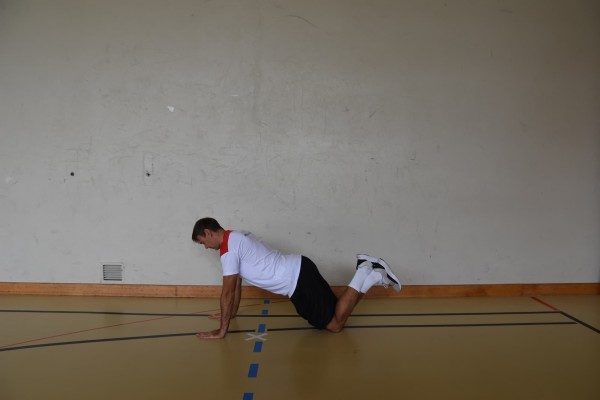
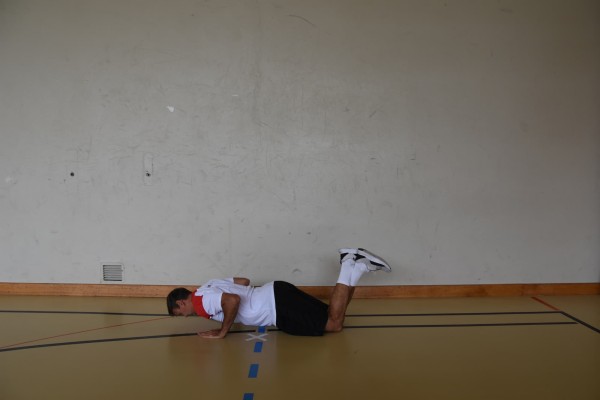
In the knee push-up position (knees on the floor, feet held high with toes raised, body forming a straight line from head to knees, hands slightly more than shoulder-width apart under the shoulders), bend and stretch the arms (lower and raise the upper body). In the deep push-up position, the elbows are at the sides of the body (no outward movement of the elbows).
Attention:
No hollow back and elbows bent at an angle of approx. 45° from the upper body ("A" shape with the arms). Keep your shoulders fixed and pull them down towards your hips.
Lighten:
Lower your upper body less (hardly bend your arms); support your arms on a raised surface.
Harden:
Additional weight (on the back); unstable support for the arms and/or legs; perform normal push-ups without knee support.
Variant:
Vary the position of the hands/arms (e.g. wide, narrow, together).
1 weight vest/weight disc/sandbag/fighting backpack ► Make the exercise more difficult (additional weight)
1 ball/1-2 balance cushion/balance board ► Make the exercise more difficult (unstable base)
1 raised base ► Make the exercise easier or more difficult (position)
Push-up on knee ► knee push up / kneeling push up (wide grip)
Power
Individual work
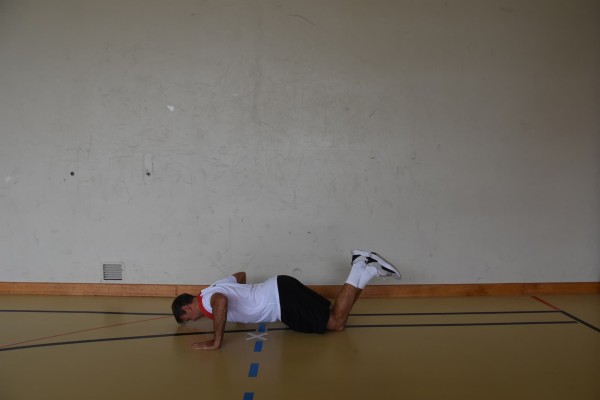
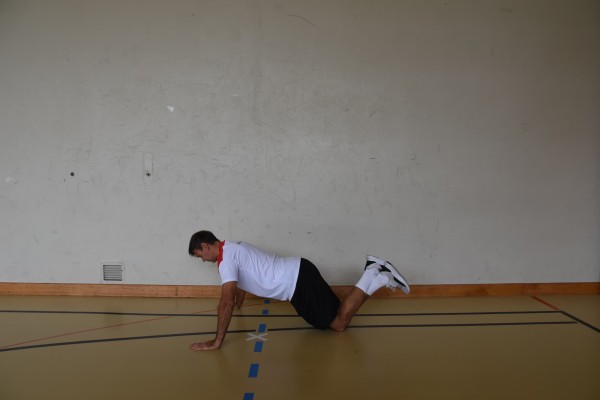
In the knee push-up position (knees on the floor, feet held high with toes raised, body forming a straight line from head to knees, hands placed significantly wider than shoulder width apart), bend and stretch the arms (lower and raise the upper body).
Attention:
No hollow back.
Lighten:
Lower your upper body less (hardly bend your arms); support your arms on a raised surface.
Harden:
Additional weight (on the back); unstable support for the arms and/or legs; perform normal push-ups without knee support.
Variant:
Vary the position of the hands/arms (e.g. wide, narrow, together).
1 weight vest/weight disc/sandbag/fighting backpack ► Make the exercise more difficult (additional weight)
1 ball/1-2 balance cushion/balance board ► Make the exercise more difficult (unstable base)
1 raised base ► Make the exercise easier or more difficult (position)
Push-up with raised buttocks ► pike push up
Power
Individual work


From the push-up position, bring your feet closer to your hands to lift your buttocks, feet on tiptoes, bend and stretch your arms (forehead to the floor and back to the starting position).
Lighten:
Place your knees on the floor; lower your upper body less (barely bend your arms). Place arms on a raised surface.
Make it harder:
Additional weight; unstable surface for the arms/legs; place legs on a raised surface.
Variant:
Vary the position of the hands/arms (e.g.: wide, narrow, together).
1 weight waistcoat ► making the exercise more difficult (additional weight)
1 raised base ► making the exercise easier or more difficult (position)
Push-up with raised buttocks and elevated leg position ► box pike push up
Power
Individual work


The legs are approximately horizontal to the floor, shoulder-width apart on a raised surface (e.g. plyo box, flat bench or vaulting box element incl. top), feet on the toes, outstretched arms are placed on the floor (slightly more than shoulder-width apart) and support the upper body (head between the arms). The buttocks are practically held above the head (straight back almost horizontal to the floor). The hip joint is at a 90 degree angle, so to speak, so that the position of the upper body and legs corresponds to the letter "L". From this position, bend your arms (forehead to the floor) and stretch back to the starting position.
Lighten:
Place your legs on the floor; lower your upper body less (barely bend your arms).
Harden:
Raise your legs additionally.
1 plyo box, flat bench, vaulting box element incl. top
1 additional elements (plyo box, vaulting box) for the raised base ► making the exercise more difficult (position)
Push-up with lifting one leg ► one leg push up
Power
Individual work
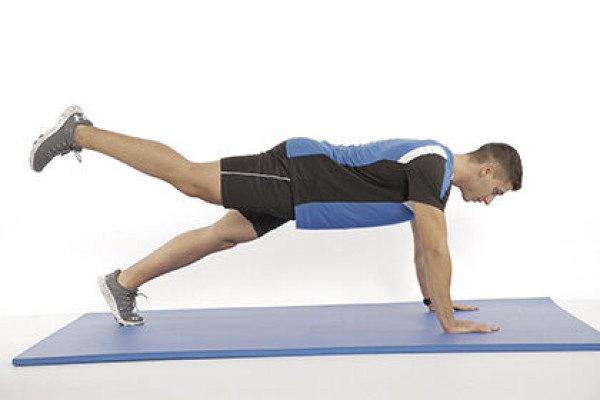

Push-up position (high support, face/look down), alternately raise one leg, lower the upper body at the same time as raising the leg and raise the upper body again when lowering the leg by bending/stretching the arms (push-up). Switch sides (legs) after each exercise.
Attention:
Stay stable (tighten your stomach), elbows bent at an angle of approx. 45° from your upper body ("A" shape with your arms), shoulders fixed and pulled down towards your hips.
Lighten:
Just hold the basic position (push-up position); bend/stretch your arms less.
Harden:
Additional weight (on your back); unstable surface (for your arms).
1 weight vest/weight disc/sandbag ► making the exercise more difficult (additional weight)
1-2 balance cushions/1 balance board ► making the exercise more difficult (unstable surface)
Push-up with wide arm position ► wide push up
Power
Individual work
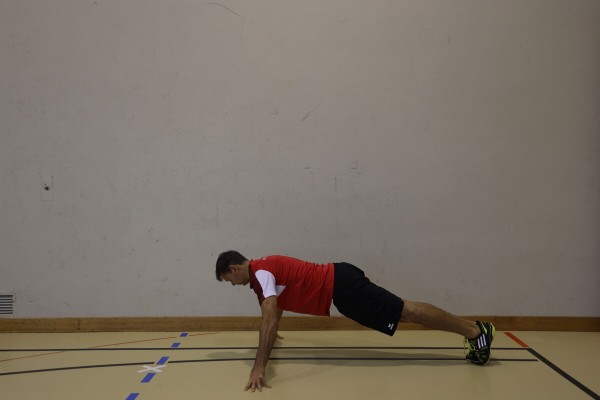
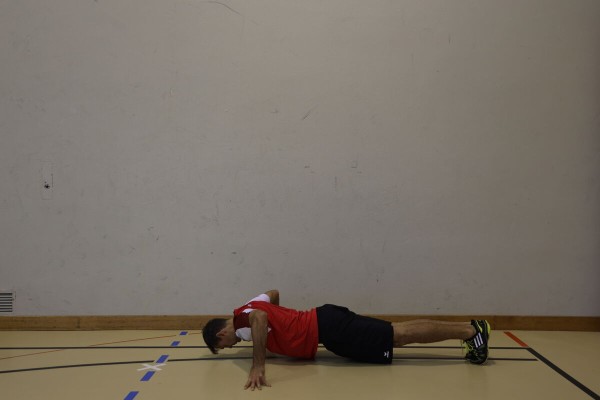
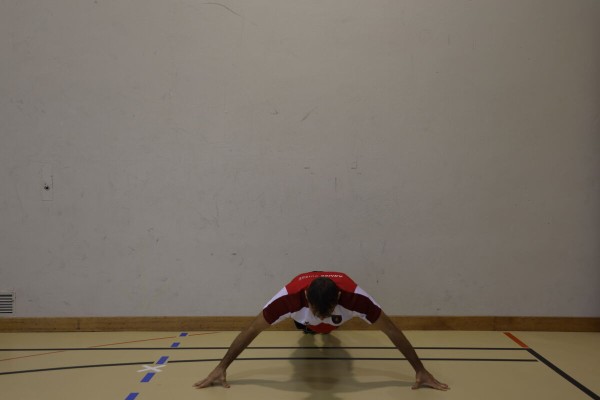
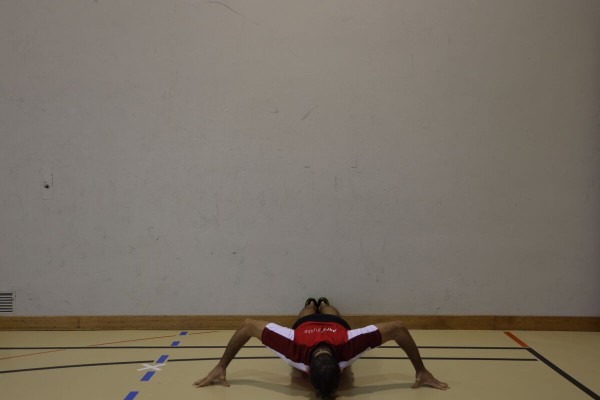
Push-up position with (very) wide arms, arms supported only on the fingers (palms not on the floor), arms bent and stretched (upper body lowered and raised).
Attention:
No hollow back, elbows bent at an angle of approx. 45° from the upper body ("A" shape with the arms). Shoulders are fixed and pressed down towards the hips.
Lighten:
Put your knees on the floor (feet held high); lower your upper body less (arms barely bent).
Harden:
Additional weight (on the back); place the legs on a raised surface; unstable surface for arms and/or legs.
1 weight vest/weight disc/sandbag ► Make the exercise more difficult (additional weight)
1 ball/1-2 balance cushion/balance board ► Make the exercise more difficult (unstable base)
1 raised base ► Make the exercise easier or more difficult (position)
Push-up with wide arm position ► wide push up / wide grip
Power
Individual work
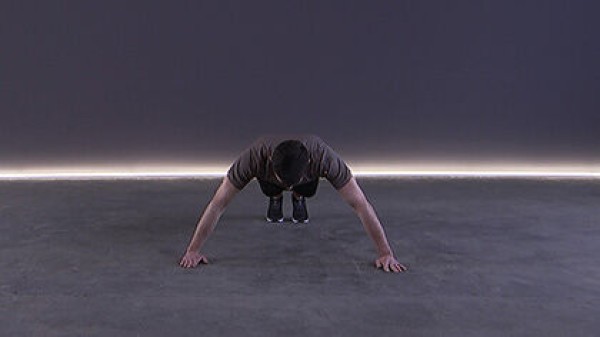

Push-up position with (very) wide arm position, bend and stretch arms (lower and raise upper body).
Attention:
No hollow back, elbows bent at an angle of approx. 45° from the upper body ("A" shape with the arms). Shoulders are fixed and pressed down towards the hips.
Lighten:
Place your knees on the floor (feet held high); lower your upper body less (arms barely bent); support your arms on a raised surface.
Harden:
Additional weight (on the back); place the legs on a raised surface; unstable surface for arms and/or legs.
1 weight vest/weight disc/sandbag ► Make the exercise more difficult (additional weight)
1 ball/1-2 balance cushion/balance board ► Make the exercise more difficult (unstable base)
1 raised base ► Make the exercise easier or more difficult (position)
Push-up with close arm position ► diamond push up / close grip
Power
Individual work


Push-up position with narrow arms (the hands can even touch under the body - form hands into a heart-shaped diamond), bend and stretch arms (lower and raise upper body).
Caution:
No hollow back, elbows bent approx. 45° from the upper body ("A" shape with the arms). Shoulders are fixed and pressed down towards the hips.
Lighten:
Place your knees on the floor (feet held high); lower your upper body less (arms barely bent); support your arms on a raised surface.
Lighten:
Additional weight (on your back); place your legs on a raised surface; unstable surface for your arms and/or legs.
1 weight vest/weight disc/sandbag ► Make the exercise more difficult (additional weight)
1 ball/1-2 balance cushion/balance board ► Make the exercise more difficult (unstable base)
1 raised base ► Make the exercise easier or more difficult (position)
Push-up with one leg bent to the side (salamander) ► lizard push up
Power
Individual work



Push-up position (high support, face/look down), bend one leg as you lower your upper body and bring it to the side of your body (knee to elbow). Switch sides after each exercise.
Caution:
Stay stable (tense your stomach).
Lighten:
Just hold the basic position (push-up position); move your leg less far forwards or barely lower your upper body (bend your arms less).
Lighten:
Additional weight (on your back or legs); unstable surface.
2 weight cuffs/1 weight vest/weight disc/sandbag ► Make the exercise more difficult (additional weight)
1-2 balance cushions/1 balance board ► Make the exercise more difficult (unstable surface)
Push up and step onto an object in push up position ► push up & stair walking push up position
Power
Individual work
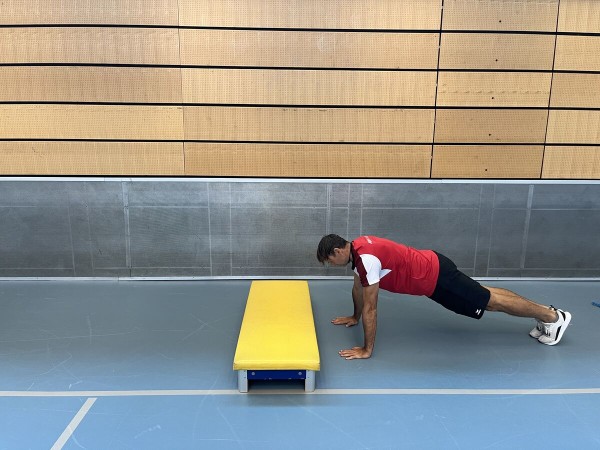
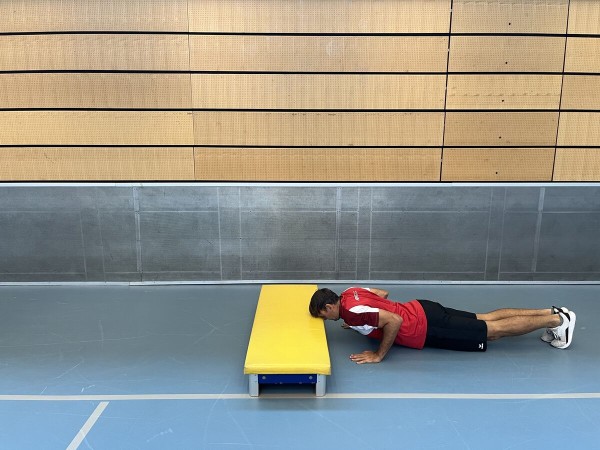
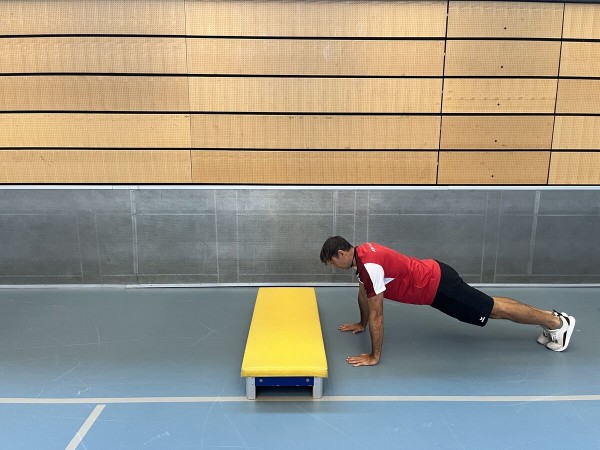


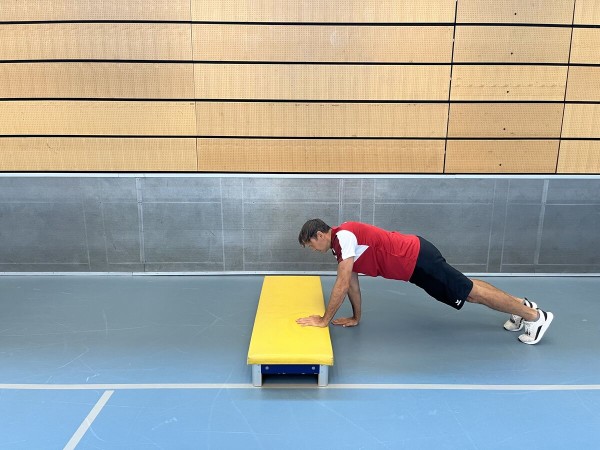
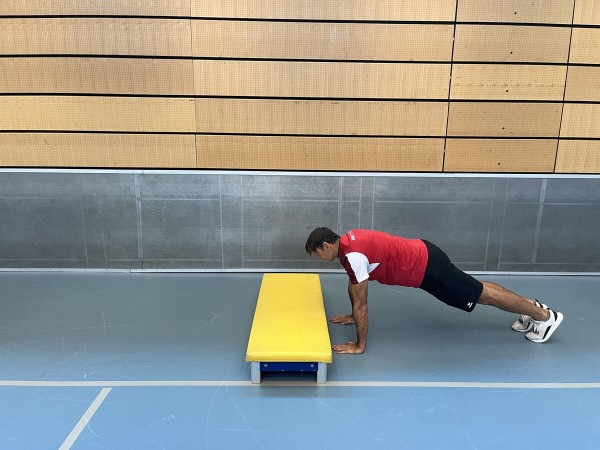
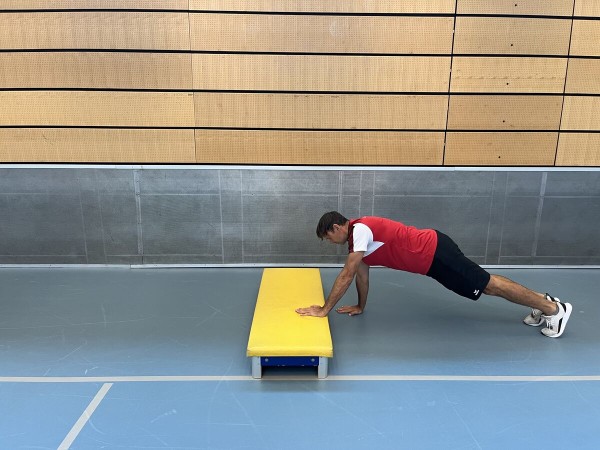
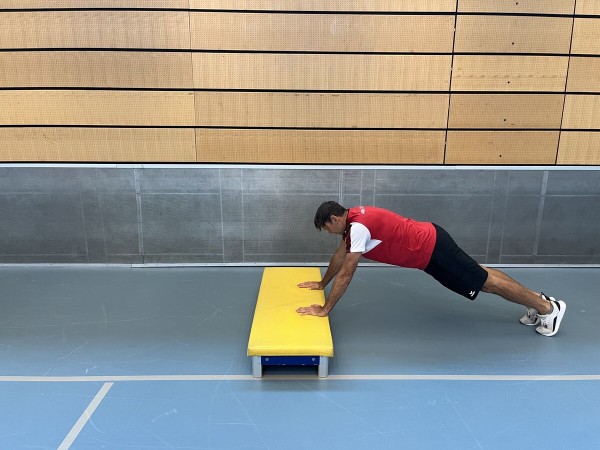
Bend and stretch your arms in the push-up position (lower and raise your upper body). In the deep push-up position, place your elbows at the side of your body (do not move your elbows outwards). Back in the push-up position, move your hands onto the top of the vaulting box one after the other and then step down to place your hands on the floor again. Start the exercise combination again, changing the starting position for each movement of the arms.
Attention:
No hollow back, tense torso, elbows bent approx. 45 degrees from the body ("A" shape with the arms), shoulders are fixed and pressed down towards the hips.
Lighten:
Supports in place (possibly raise arms slightly alternately). Alternate raising your arms slightly); replace moving your arms to the top of the box with another exercise, e.g. touching your shoulders crosswise alternately with your hand in a push-up position or stretching your arm forwards.
Harden:
Higher object (e.g. additional swing box element or long bench); additional weight (on the back); unstable surface for the legs.
Variant:
In push-up position on the swing box element or after each push-up, alternately bring the hand crosswise to the shoulder (shoulder tap) or stretch out forwards.
1 vaulting box top
1 additional vaulting box element or 1 long bench ► Make the exercise more difficult (position)
1 weight vest/weight disc/sandbag ► Make the exercise more difficult (additional weight)
1 ball/balance cushion/balance board ► Make the exercise more difficult (unstable base)
Push-up and step onto an object and cross your hand over your shoulder in push-up position ► push up & stair walking and shoulder tap push up position
Power
Individual work
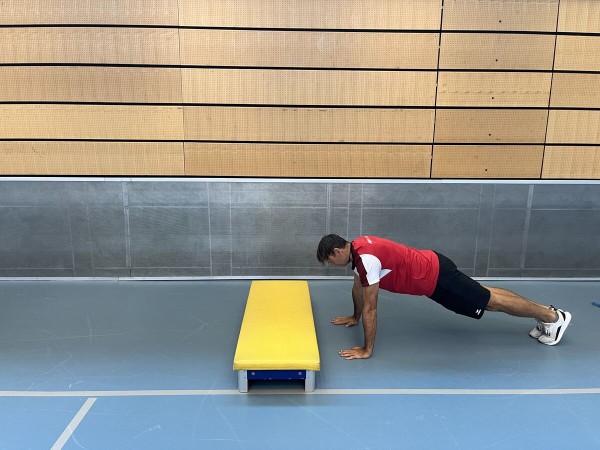

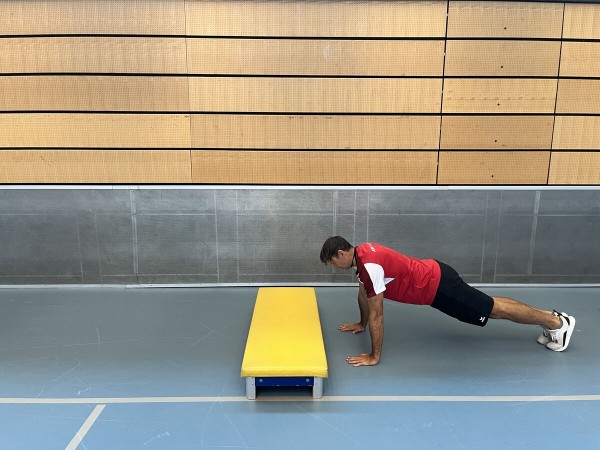

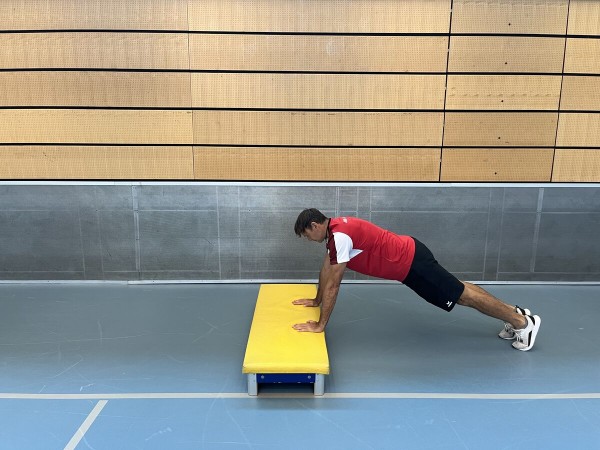

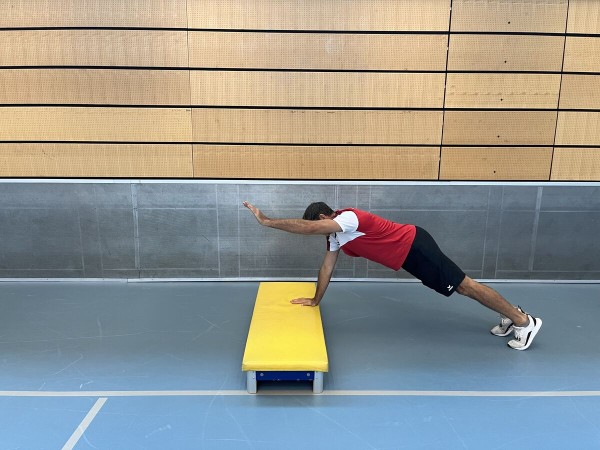
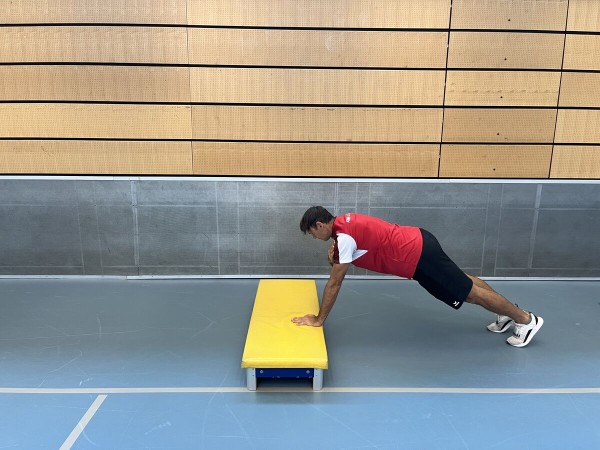
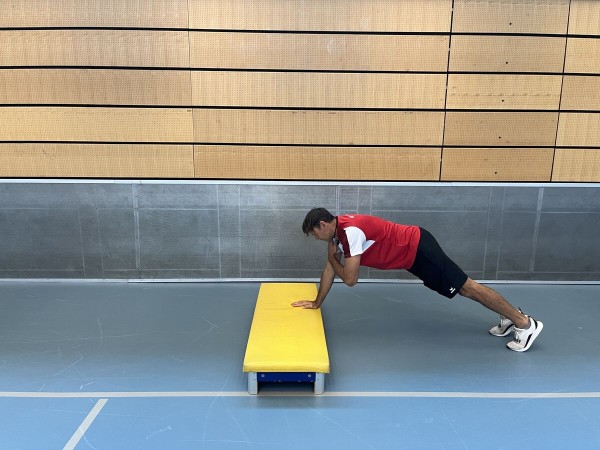
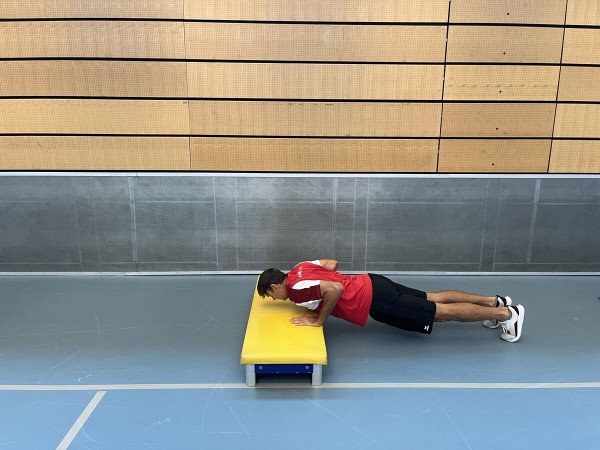
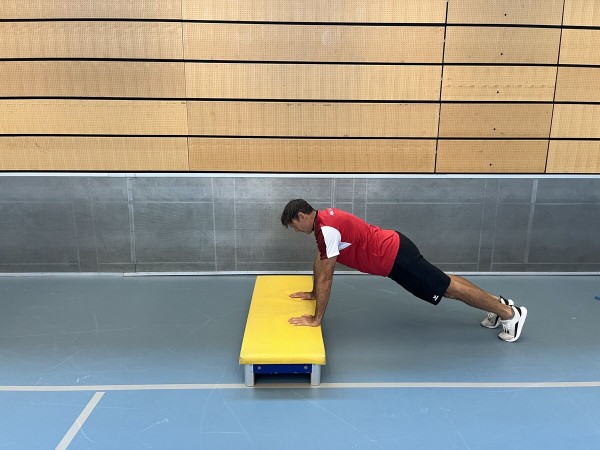


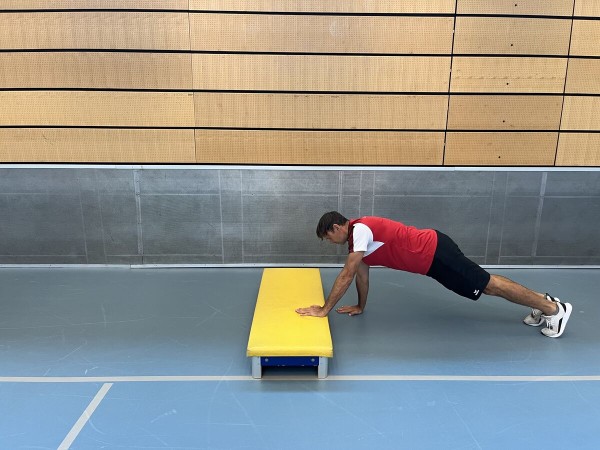
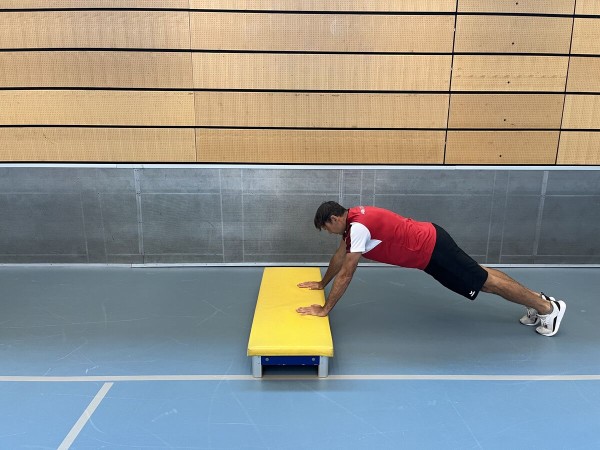
Bend and stretch your arms in the push-up position (lower and raise your upper body). In the deep push-up position, place your elbows at the side of your body (do not move your elbows outwards). Back in the push-up position, move your hands one after the other to the top of the swinging box, alternate between bringing your hand crosswise to your shoulder (shoulder tap) and/or stretching it forwards in the push-up position on the swinging box element. Then step down to place your hands on the floor again. Start the exercise combination again, changing the starting position each time you move your arms.
Attention:
No hollow back, tense torso, elbows bent approx. 45 degrees from the body ("A" shape with the arms), shoulders are fixed and pressed down towards the hips.
Lighten:
Supports in place (possibly raise arms slightly alternately). Alternate raising your arms slightly); replace moving your arms to the top of the box with another exercise, e.g. touching your shoulders alternately with your hand crosswise in a push-up position or stretching your arm forwards.
Harden:
Higher object (e.g. additional swing box element or long bench); additional weight (on the back); unstable surface for the legs.
Variant:
Also perform a push-up on the top of the swing box before or after moving the hand crosswise to the shoulder and/or extending the arms.
1 vaulting box top
1 additional vaulting box element or 1 long bench ► Make the exercise more difficult (position)
1 weight vest/weight disc/sandbag ► Make the exercise more difficult (additional weight)
1 ball/balance cushion/balance board ► Make the exercise more difficult (unstable base)
Alternating push-ups and upright stance ► no jump burpee
Power
Individual work

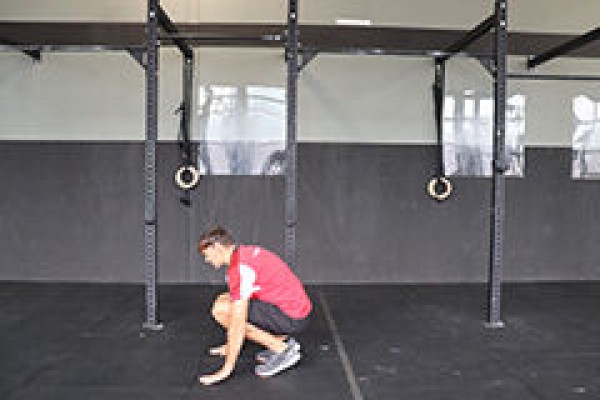





From a standing position, bend your legs and place your hands next to (in front of) your feet to get into a squat position. Support yourself with your hands, jump backwards with both legs to get into the push-up position. Bend your arms to fully lower your upper body (prone position). From the prone position, use both arms to push yourself back into the push-up position and jump back into a squat. From this squatting position, straighten up completely back to standing (push your pelvis forwards, push your chest forwards, push your arms back slightly/press your shoulders back).
Lighten:
Lower intensity between the individual exercises.
Harden:
Additional weight.
2-4 weight cuffs/1 weight waistcoat ► Make the exercise more difficult (additional weight)
Push up and cross hand to shoulder in push up position alternating ► push up & shoulder tap push up positon
Power
Individual work


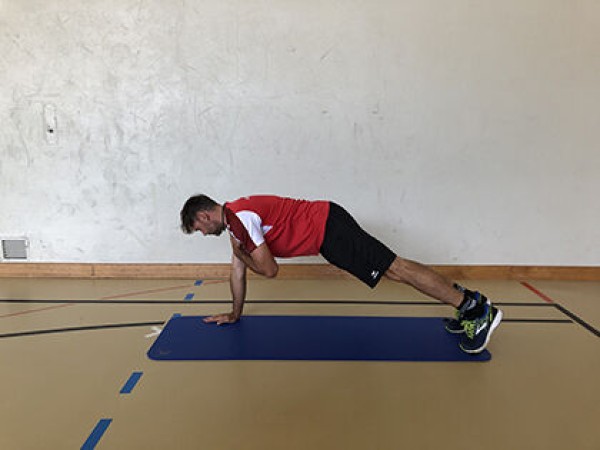

Push-up position (high support, face/look down), bring one hand crosswise to the shoulder, then perform the same movement with the other hand. Then bend and stretch your arms in the push-up position (lower and raise your upper body) before touching both shoulders alternately again.
Attention:
In the push-up position, your head, torso, hips and knees practically form a line (do not stretch your buttocks upwards or let them sag, tense your stomach). During the push-up, do not arch your back and bend your elbows at an angle of approx. 45° from your upper body ("A" shape with your arms). The shoulders are fixed and pulled down towards the hips.
Lighten:
Just hold the basic position (push-up position); during the push-up, place your knees on the floor or lower your upper body less (barely bend your arms).
Harden:
Additional weight (on your back or arms); unstable surface.
2 weight cuffs/1 weight vest/weight disc/sandbag ► Make the exercise more difficult (additional weight)
1-2 balance cushions/1 balance board ► Make the exercise more difficult (unstable surface)
Push-up and jump up (squat jump) alternating ► burpee tuck jump
Power
Individual work

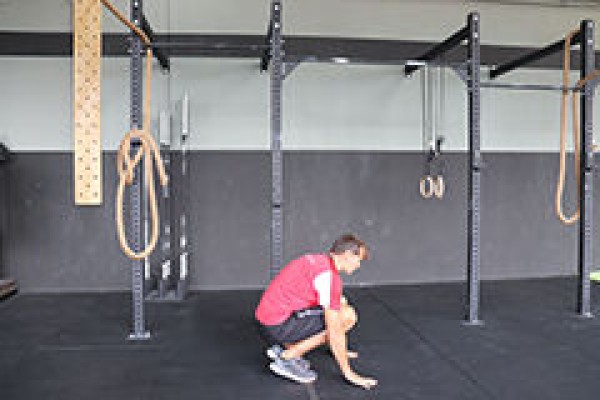

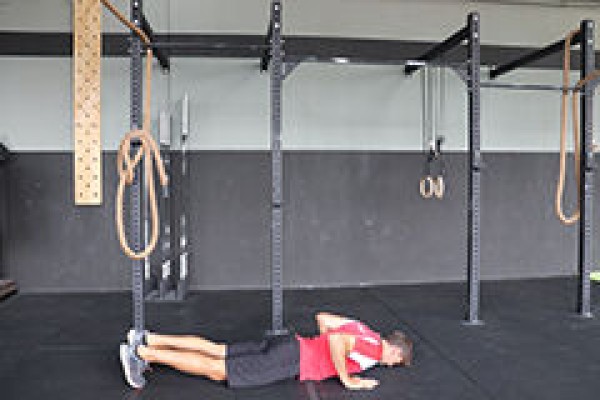





From a standing position, bend your legs and place your hands next to your feet to get into a squat position. Support yourself with your hands, jump backwards with both legs to get into the push-up position. Bend your arms to fully lower your upper body (prone position). From the prone position, push back into the push-up position with both arms and jump back into a squat position. From this position, push your legs off the floor to jump up (raise your arms horizontally as a swing). During the jump, pull your knees up towards your chest as far as possible (squat jump - bend your arms in front of your body, forearms parallel to the floor, elbows close to your body, palms facing downwards at approximately the level of your navel). Then land in a controlled manner (cushion the jump) to initiate the next repetition (prone position/lying down) by bending the legs.
Attention:
Keep your back straight when jumping up, cushion the landing, keep your whole foot firmly on the ground without bending your knees while your legs are in contact with the floor and keep your knees behind your toes. The palms of the hands touch the knees with every jump. No hollow back in the push-up position (body tension).
Lighten:
Lower intensity between the individual exercises; smaller/less intense jumps, knees pulled up less far; in the squat position, only jump backwards and back again with the legs (without prone position/push-up).
Harden:
Additional weight; soft surface.
2-4 weight cuffs/1 weight waistcoat ► making the exercise more difficult (additional weight)
1 soft mat small/large ► making the exercise more difficult (base)
Push-up as well as jump up and lunge alternating in the jump (alternating jump) ► gorilla burpee
Power
Individual work












From a standing position, bend your legs and place your hands next to (in front of) your feet to assume the squat position. Support yourself with your hands, jump backwards with both legs at the same time to get into the push-up position. Bend your arms to fully lower your upper body (prone position). From the prone position, use both arms to push yourself back into the push-up position and jump back into a squat. From the squat position, perform a jump upwards (without raising your arms overhead; arms hanging down towards the floor) and land back in the starting position (standing). During the jump, alternate between bringing the left and right leg backwards (alternating jumps) in order to assume the lunge position twice (arms supported on the hips or one arm bent at chest height in the opposite direction to the standing leg and the other arm hanging down towards the floor). After the second jump, the free leg is moved to the supporting leg so that the upright standing position is assumed again and the exercise can be restarted.
Attention:
When performing the alternating jumps, always keep the front knee behind the tip of the foot and centred over the foot; the upper body should remain as stable as possible.
Lighten:
Lower intensity between the individual exercises; lower height during the stretch jump (or only straighten the upper body); integrate lunges backwards (no alternating jumps).
Harden:
Additional weight.
2-4 weight cuffs/1 weight waistcoat ► Make the exercise more difficult (additional weight)
Alternating push-up and jump into the distance ► burpee broad jump
Power
Individual work








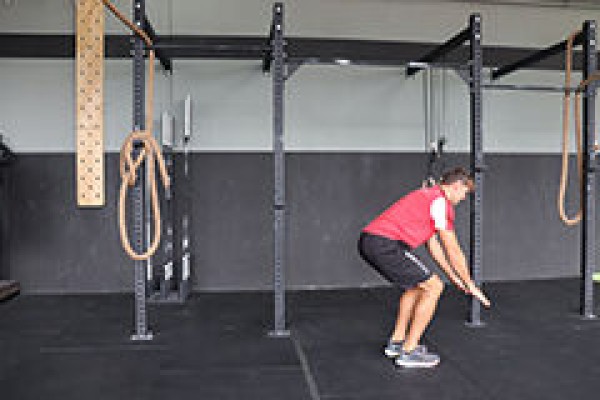








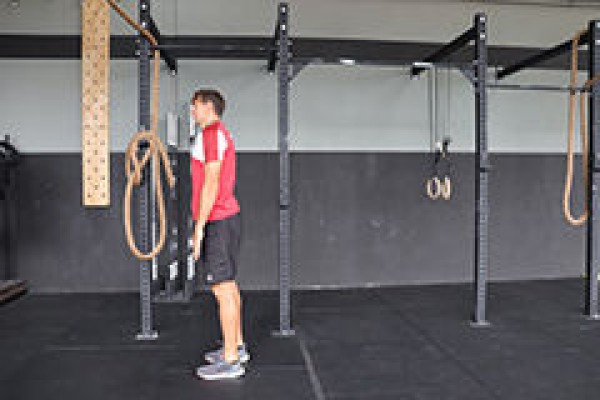
From a standing position, bend your legs and place your hands next to your feet to get into a squat position. Support yourself with your hands, jump backwards with both legs to get into the push-up position. Bend your arms to fully lower your upper body (prone position). From the prone position, push back into the push-up position with both arms and jump back into a squat position. From the squat position, tilt your upper body slightly forwards, stretch your arms backwards at an angle to your body (like a ski jumper on a ski jump), push off the floor powerfully to perform a jump into the air (use the momentum of your arms). Then land in a controlled manner (cushion the jump; bend your knees), stretch your legs and straighten your upper body to get to a standing position. A half turn around your own body axis (180 degrees) before the next exercise ensures that not too much space is required so that you can land again at the original location/starting point.
Attention:
No hollow back in the push-up position (body tension); land as softly as possible on the floor (cushion the jump with your knees) and lower your buttocks backwards (do not move your knees forwards), maintain your balance with bent knees after each landing.
Lighten:
Lower intensity between each execution; less wide/intense jumps.
Harden:
Additional weight; wider/intense jumps; adjust the terrain (incline).
Variation:
Jump over an obstacle.
2-4 weight cuffs/1 weight waistcoat 2-4 weight cuffs/1 weight waistcoat ► Make the exercise more difficult (additional weight)
1 bench/ball/hurdles/kettlebell/fighting backpack/helmet etc. ► Variation of the exercise (obstacle)
Push-up and stretch jump alternating ► double push up burpee
Power
Individual work


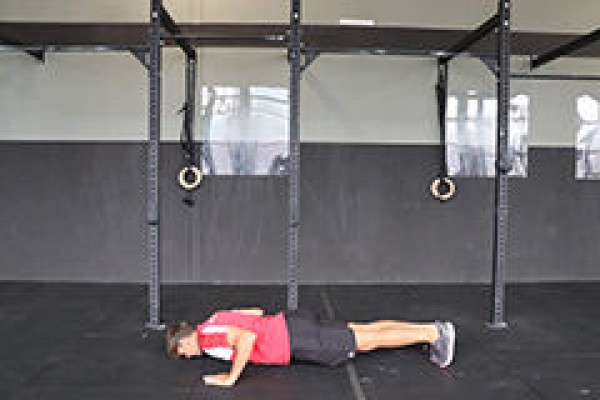
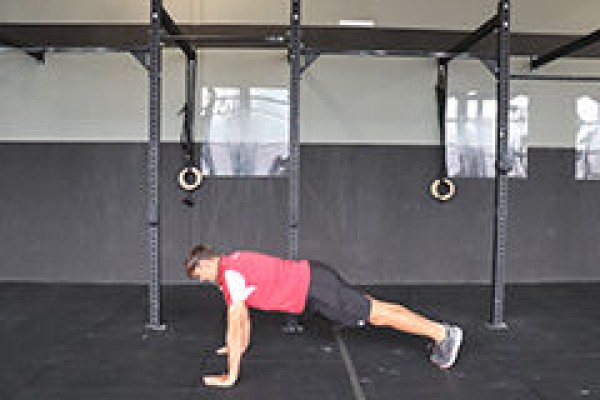


From a standing position, bend your legs, place your hands in front of your feet and hop backwards with both legs at the same time to get into the push-up position. In the push-up position (high support, face/look down), bend and stretch your arms twice (bring your chest to the floor). Then jump back forwards with both legs to the starting position of the legs. From the squatting position, perform a stretch jump (optionally cross your arms briefly behind your head during the flight phase) and land back in the starting position to begin the exercise again.
Attention:
Do not perform a hollow back in the push-up position (body tension).
Lighten:
Lower intensity between the individual exercises; lower height during the stretch jump (or only straighten the upper body); only assume the push-up position without bending or straightening the arms (do not perform push-ups) or integrate only one push-up instead of two.
Harden:
Additional weight.
2-4 weight cuffs/1 weight waistcoat ► Make the exercise more difficult (additional weight)
Alternating push-ups and lifting an object
Power
Individual work
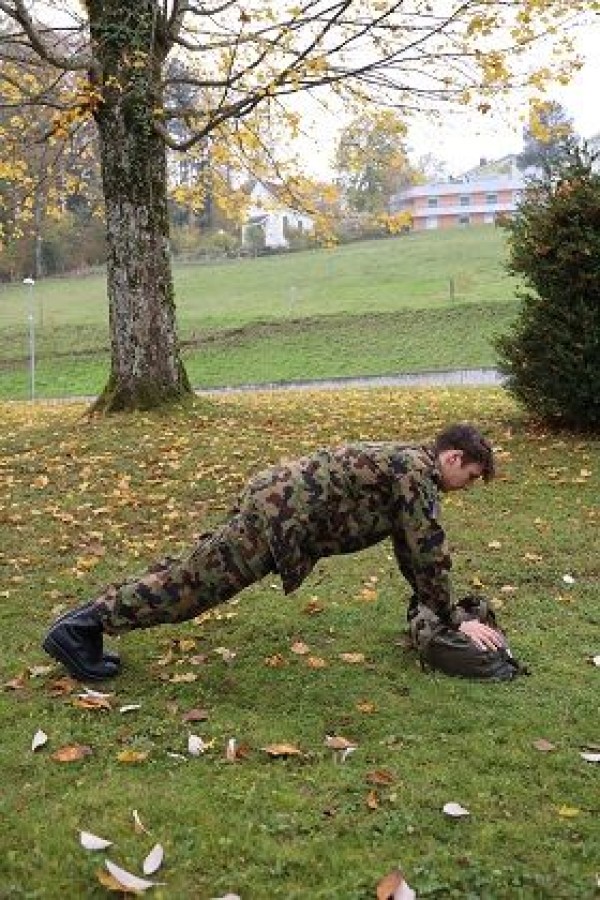
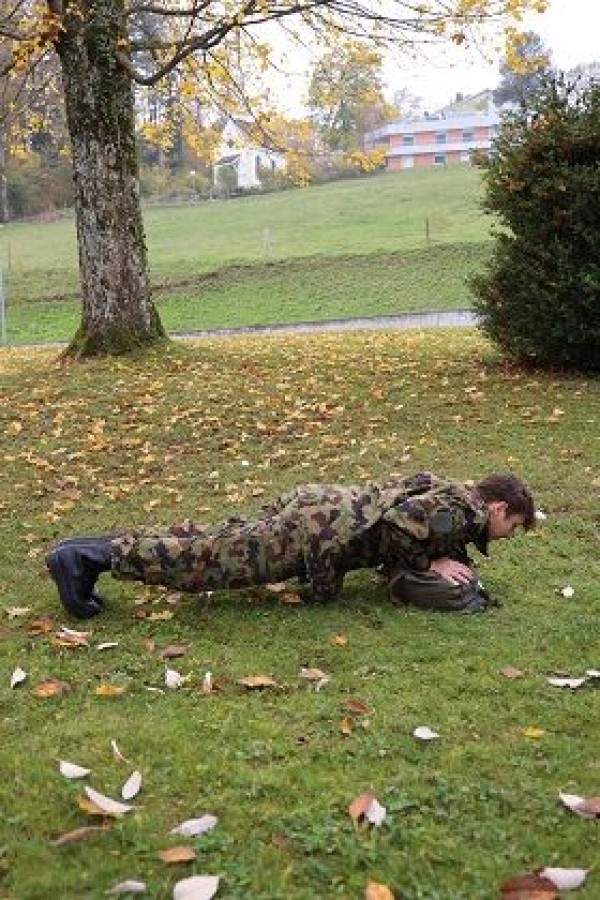
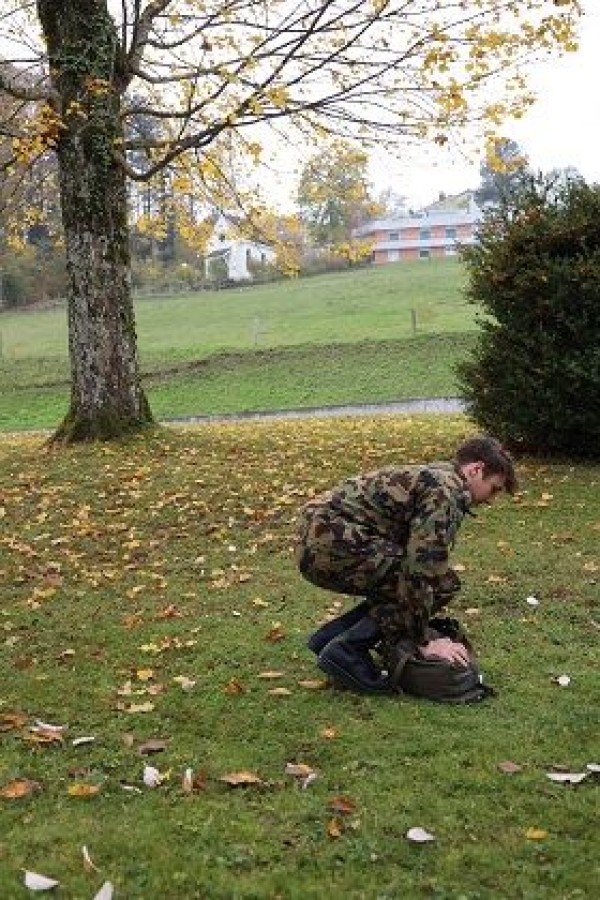
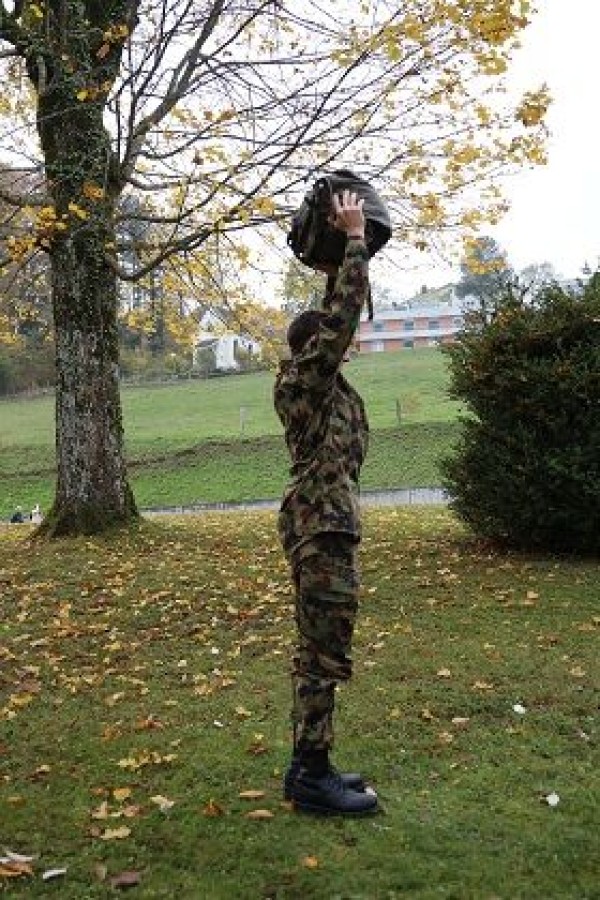
Push-up position with your arms supported on an object (e.g. rucksack), bend and stretch your arms (lower and raise your upper body), stand up (jump with your feet to your hands, then raise your upper body), lift the object and hold it above your head with your arms outstretched, place the object on the floor and return to the push-up position to start the movement sequence again.
Attention:
No hollow back in the push-up position, elbows bent approx. 45 degrees from the upper body ("A" shape with the arms), shoulders are fixed and pushed down towards the hips. Cushion the landing with your feet.
Lighten:
Less weight/load.
Lie down: Place knees on the floor (feet held high); lower upper body less (barely bend arms). Stretch jump: less high/impulsive.
Harden:
More weight/greater load.
Variant:
Vary the position of the hands/arms (e.g.: wide, narrow, together).
1 combat rucksack/(medicine) ball
1 helmet ► make the exercise easier
1 sandbag/tyre (PUCH) ► make the exercise more difficult (additional weight)
Alternating push-ups and lifting an object
Power
Individual work




Push-up position with your arms resting on the assault rifle, bend and stretch your arms (lower and raise your upper body), stand up (jump with your feet to your hands, then raise your upper body), hold the rifle up (arms extended above your head), place the rifle on the floor and return to the push-up position to start the movement sequence from the beginning.
Attention:
No hollow back in the push-up position, elbows bent approx. 45 degrees from the upper body ("A" shape with the arms), shoulders are fixed and pushed down towards the hips. Land with your feet to cushion the landing.
Lighten:
Lie down: Place your knees on the floor (feet held high); lower your upper body less (barely bend your arms). Stretch jump: less high/impulsive.
Variant:
Vary the position of the hands/arms (e.g.: wide, narrow, together).
1 assault rifle (neutralised)
Alternating push-up and jump onto an object ► burpee & box jump
Power
Individual work



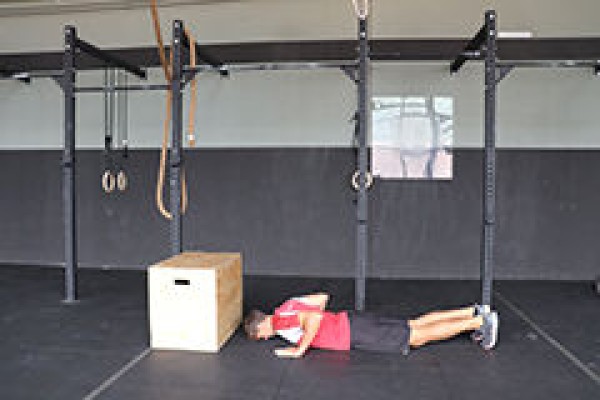





From a standing position, bend your legs and place your hands next to your feet to get into a squat position. Support yourself with your hands and jump backwards with both legs to get into a push-up position. Bend your arms to fully lower your upper body (prone position). From the prone position, push back into the push-up position with both arms and jump back into the squat position. From the squat position, tilt your upper body slightly forwards, stretch your arms backwards at an angle to your body (like a ski jumper on a ski jump), push off the floor powerfully to perform a jump onto the plyo box (using the momentum of your arms), straighten your upper body (standing on the box) and jump back to the starting position (possibly the other side of the box).
Attention:
No hollow back in the push-up position (body tension); land on the box as softly as possible (cushion the jump with your knees).
Lighten:
Lower intensity between the individual exercises; lower the height of the box.
Harden:
Additional weight; higher plyo box.
Variation:
Bouncing from one side of the plyo box to the other by jumping sideways.
1 flat bench/plyo box/swivel box
2-4 weight cuffs/1 weight waistcoat ► Make the exercise more difficult (additional weight)
Push-up and jump over the rower ► burpee over rower
Power
Individual work







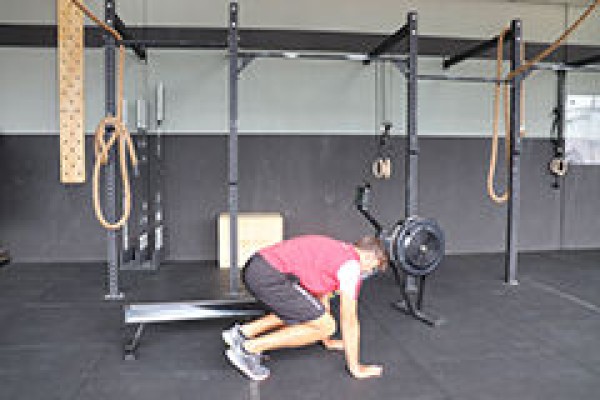







From a standing position, bend your legs and place your hands next to your feet to get into a squat position. Support yourself with your hands and jump backwards with both legs to get into a push-up position. Bend your arms to fully lower your upper body (prone position). From the prone position, push back into the push-up position with both arms and jump back into the squat position. In the squat position, the upper body is tilted slightly forwards, stretch your arms backwards at an angle to your body (like a ski jumper on a ski jump), push off the floor powerfully to perform a jump (lateral-sided) over the back of the rowing machine (use the momentum of the arms). Straighten your upper body and restart the exercise (assume the push-up position) to finally jump back to the starting position.
Attention:
Do not arch your back in the push-up position (body tension); land on the floor as softly as possible (cushion the jump with your knees); be careful with the jump height when jumping over the rowing machine.
Lighten:
Lower intensity between the individual exercises; only jump into the push-up position and back into the squat (without prone position/push-up).
Harden:
Additional weight; higher intensity between the individual exercises.
Variant I:
Jump frontally over the rowing machine.
Variant II:
Integrate rowing units (defined distance, time or watts).
1 rowing machine
2-4 weight cuffs / 1 weight waistcoat ► Make the exercise more difficult (additional weight)
Push-up and jump over the dumbbell ► burpee over dumbbell
Power
Individual work
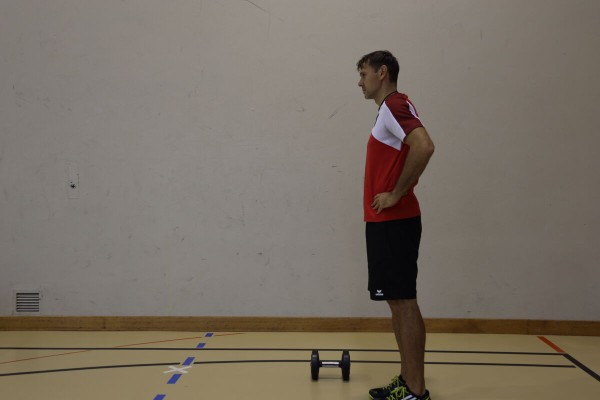

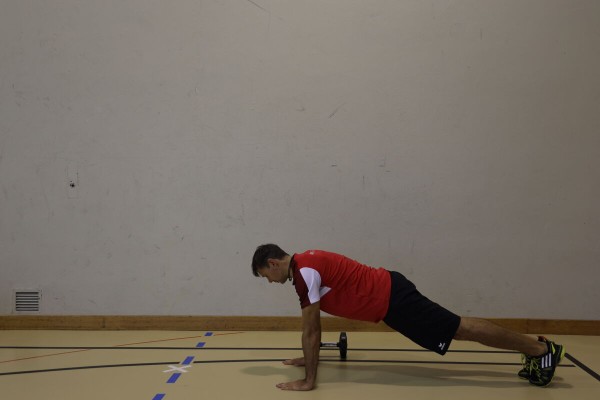
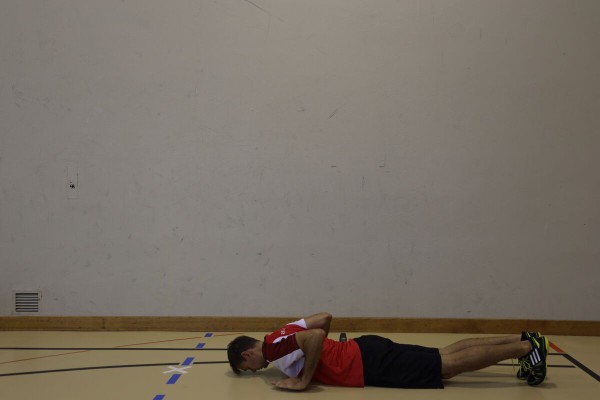
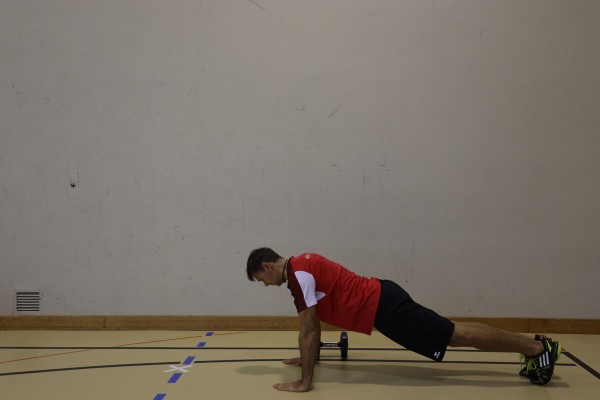
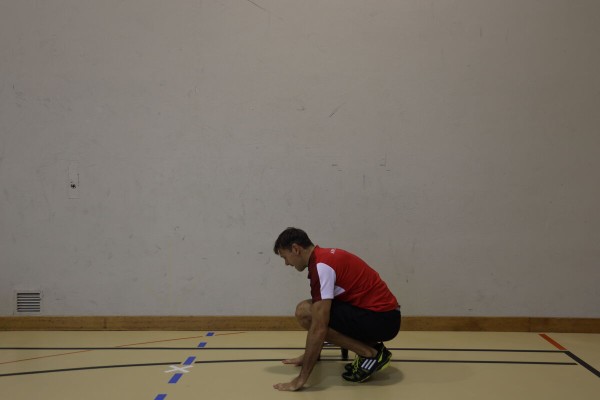
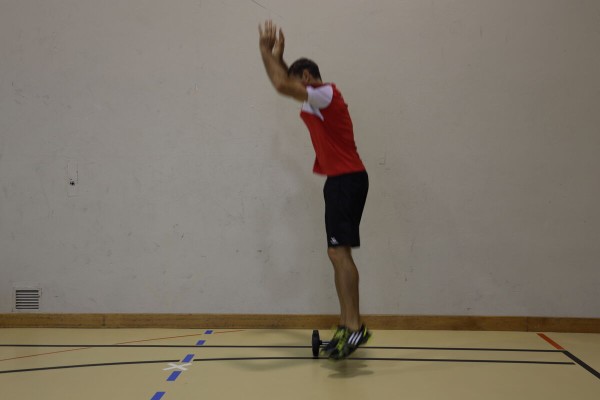
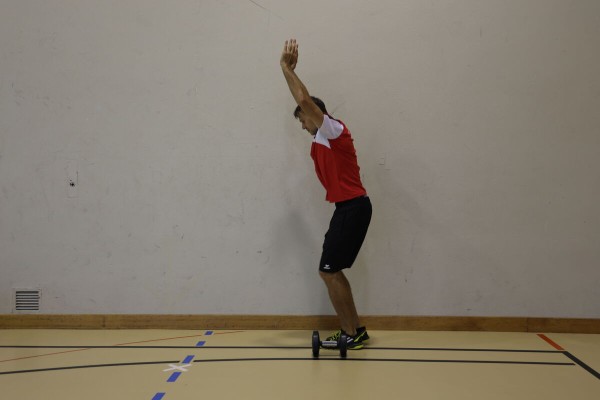
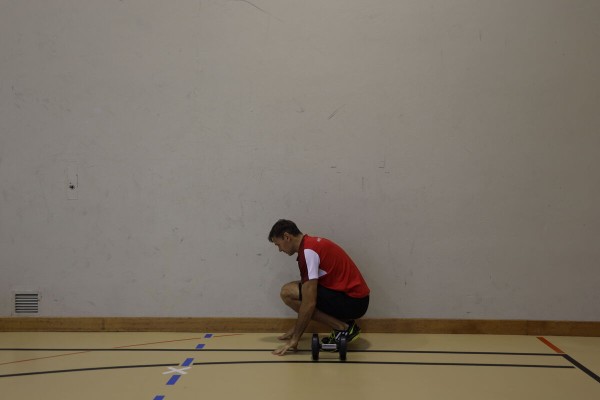
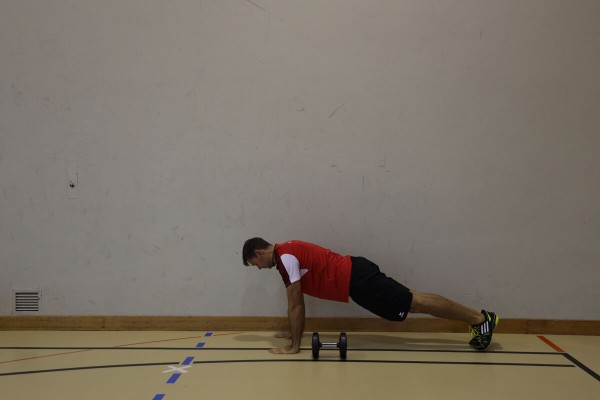
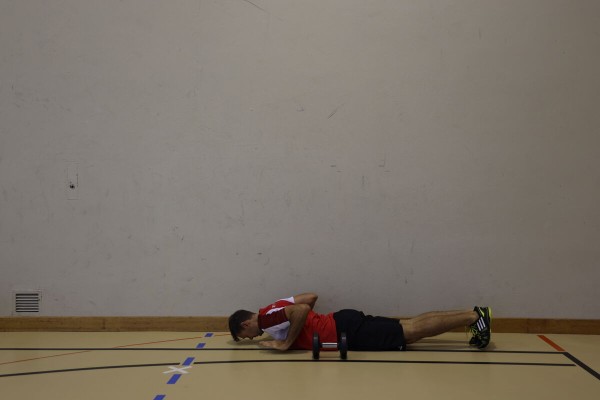

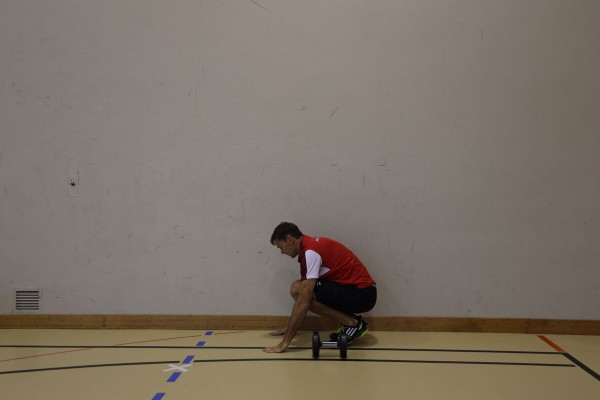
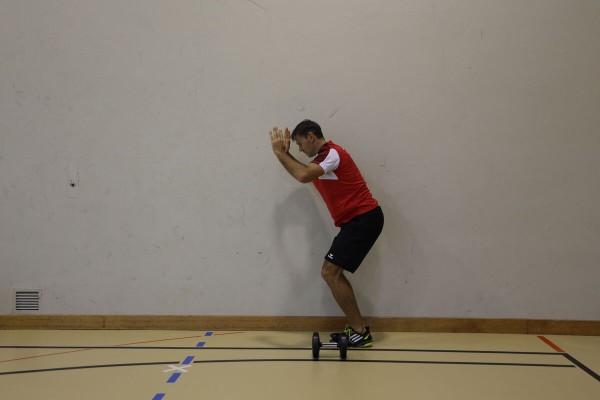
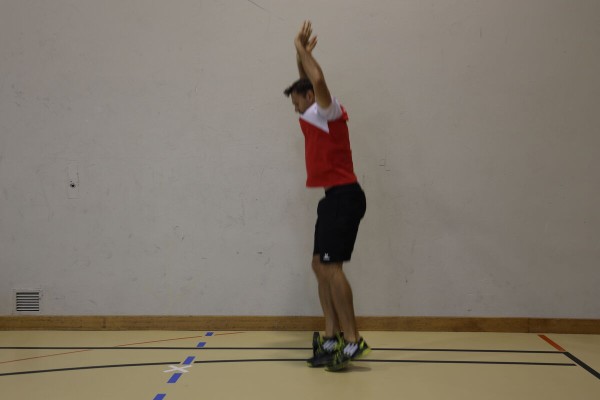
From a standing position, bend your legs and place your hands next to your feet to get into a squat position. Support yourself with your hands and jump backwards with both legs to get into a push-up position. Bend your arms to fully lower your upper body (prone position). From the prone position, push back into the push-up position with both arms and jump back into the squat position. In the squat position, the upper body is tilted slightly forwards, stretch your arms backwards at an angle to your body (like a ski jumper on a ski jump), push off the floor powerfully to perform a jump (lateral-sided) over the dumbbell (use the momentum of the arms). Straighten your upper body and restart the exercise (assume a push-up position) to finally jump back to the starting position.
Attention:
Do not arch your back in the push-up position (body tension); land on the floor as softly as possible (cushion the jump with your knees).
Lighten:
Lower intensity between the individual exercises; only jump into the push-up position and back into the squat (without prone position/push-up).
Harden:
Additional weight; higher intensity between the individual exercises.
Variant I:
Frontal jump over the dumbbell.
1 dumbbell (kettlebell)
2-4 weight cuffs / 1 weight waistcoat ► Make the exercise more difficult (additional weight)
Push-up and jump over the barbell ► burpee over bar
Power
Individual work









From a standing position, bend your legs and place your hands next to your feet to get into a squat position. Support yourself with your hands and jump backwards with both legs to get into a push-up position. Bend your arms to fully lower your upper body (prone position). From the prone position, push back into the push-up position with both arms and jump back into the squat position. In the squat position, the upper body is tilted slightly forwards, stretch your arms backwards at an angle along your body (like a ski jumper on a ski jump), push off the floor powerfully to perform a jump (lateral-sided) over the barbell (use the momentum of the arms). Straighten your upper body and restart the exercise (assume a push-up position) to finally jump back to the starting position.
Attention:
Do not arch your back in the push-up position (body tension); land on the floor as softly as possible (cushion the jump with your knees); be careful with the jump height when jumping over the barbell.
Lighten:
Lower intensity between the individual exercises; only jump into the push-up position and back into the squat (without prone position/push-up).
Harden:
Additional weight; higher intensity between the individual exercises.
Variant I:
Jump over the barbell from the front.
1 barbell
2-4 weight cuffs / 1 weight waistcoat ► Make the exercise more difficult (additional weight)
Alternating push-ups and stretch jumps ► burpee
Power
Individual work



From a standing position, bend your legs and place your hands next to your feet to get into a squat position. Support yourself with your hands, jump backwards with both legs to get into the push-up position. Bend your arms to fully lower your upper body (prone position). From the prone position, push back into the push-up position with both arms and jump back into the squat position. From the squat position, perform a stretch jump and land back in the starting position (standing).
Attention:
Do not arch your back in the push-up position (body tension).
Lighten:
Lower intensity between the individual exercises; lower height for the stretch jump (or just straighten your upper body); place your knees on the floor for the push-ups (feet held high).
Harden:
Additional weight.
2-4 weight cuffs/1 weight waistcoat ► Make the exercise more difficult (additional weight)